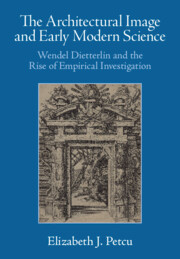 The Architectural Image and Early Modern Science
The Architectural Image and Early Modern Science Book contents
- The Architectural Image and Early Modern Science
- Reviews
- The Architectural Image and Early Modern Science
- Copyright page
- Dedication
- Contents
- Editorial Note
- Acknowledgements
- Introduction The Renaissance of Architecture as Art and Science
- One Architecture’s Figural Turn
- Two Devising the Architectura: Rationalism and Empiricism in Architectural Design
- Three Drafting the Architectura: Drawing as Research in Art, Architecture, and Science
- Four Printing the Architectura: Architectural Etching Becomes Alchemical Inquiry
- Five Dissecting the Architectura: Anatomy, Ornament, and the Limits of Figuration
- Six Deconstructing the Architectura: Enduring Matter and Transient Forms in Peru
- Conclusion The Death and the Life of the Architectural Image
- Select Bibliography
- Index
Introduction - The Renaissance of Architecture as Art and Science
Published online by Cambridge University Press: 29 November 2024
- The Architectural Image and Early Modern Science
- Reviews
- The Architectural Image and Early Modern Science
- Copyright page
- Dedication
- Contents
- Editorial Note
- Acknowledgements
- Introduction The Renaissance of Architecture as Art and Science
- One Architecture’s Figural Turn
- Two Devising the Architectura: Rationalism and Empiricism in Architectural Design
- Three Drafting the Architectura: Drawing as Research in Art, Architecture, and Science
- Four Printing the Architectura: Architectural Etching Becomes Alchemical Inquiry
- Five Dissecting the Architectura: Anatomy, Ornament, and the Limits of Figuration
- Six Deconstructing the Architectura: Enduring Matter and Transient Forms in Peru
- Conclusion The Death and the Life of the Architectural Image
- Select Bibliography
- Index
Summary
Artists, natural philosophers, and architects in fifteenth- and sixteenth-century northern Europe regarded images and image-making as sources of knowledge. Diverse practitioners of art, architecture, and natural philosophy – from artists Albrecht Dürer and Martin Schongauer to medical practitioner Walther Hermann Ryff and natural historian Conrad Gessner – used images to revive Vitruvius’s vision of architecture as both art and science, for instance in collaborating to complete the Strasbourg Astronomical Clock in 1574. Architectural ornament came to act as a model for visualizing nature’s regular forms and systems, playing a vital role in the revival of such Vitruvian interdisciplinarity. That process, in turn, prompted early modern architects and designers of architectural ornament to combine artistic and scientific techniques of visual research, a phenomenon exemplified in Dietterlin’s Architectura treatise.
Keywords
Information
- Type
- Chapter
- Information
- The Architectural Image and Early Modern ScienceWendel Dietterlin and the Rise of Empirical Investigation, pp. 1 - 44Publisher: Cambridge University PressPrint publication year: 2024